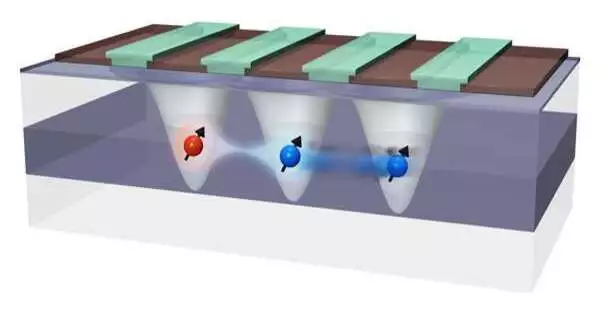The fundamental building block of quantum information, the qubit, has been connected by RIKEN physicists in a demonstration that could aid in scaling up quantum computers made of tiny silicon dots.
Many major IT companies, such as IBM, Google, and Microsoft, are vying to create quantum computers, some of which have already shown the ability to significantly outperform conventional computers for specific types of calculations. But scaling up quantum computers from a few hundred to millions of qubits is one of the biggest obstacles to creating commercially viable quantum computers.
Silicon quantum dots, which have a diameter of a few tens of nanometers, are one of the technologies that are most likely to enable large-scale quantum computing. The fact that they can be produced using current silicon fabrication technology is a major benefit. One problem, however, is that connecting quantum systems that are far apart has proven challenging; connecting systems that are close to one another, on the other hand, is simple.
“In order to connect numerous qubits, we must densely pack many of them into a very small area, and connecting such densely packed qubits with wires is quite difficult.”
Akito Noiri of the RIKEN Center for Emergent Matter Science.
“We have to densely pack many of them into a very small area in order to connect many qubits,” says Akito Noiri of the RIKEN Center for Emergent Matter Science. And connecting such tightly packed qubits with wires is very difficult.”.
Noiri and colleagues have now successfully developed a two-qubit logic gate between physically separated silicon spin qubits.
Although a lot of work has been done in this area using different methods, Noiri claims that this is the first instance in which a reliable logic gate made of two dispersed qubits has been successfully demonstrated. The demonstration makes scaling up quantum computing based on silicon quantum systems possible.”.
The team used coherent spin shuttling, a technique that enables single spin qubits to be moved across an array of quantum dots without affecting their phase coherence—a crucial characteristic for quantum computers as it carries information—to connect the two qubits. This technique uses an electrical charge to force electrons through a grid of qubits.
Noiri is certain that the physical separation between the two qubits can be increased in subsequent studies, despite the fact that it occurred only briefly. He states, “We want to increase the separation to about a micrometer or so. The method will be more useful in the future as a result.”.
More information: Akito Noiri et al, A shuttling-based two-qubit logic gate for linking distant silicon quantum processors, Nature Communications (2022). DOI: 10.1038/s41467-022-33453-z





